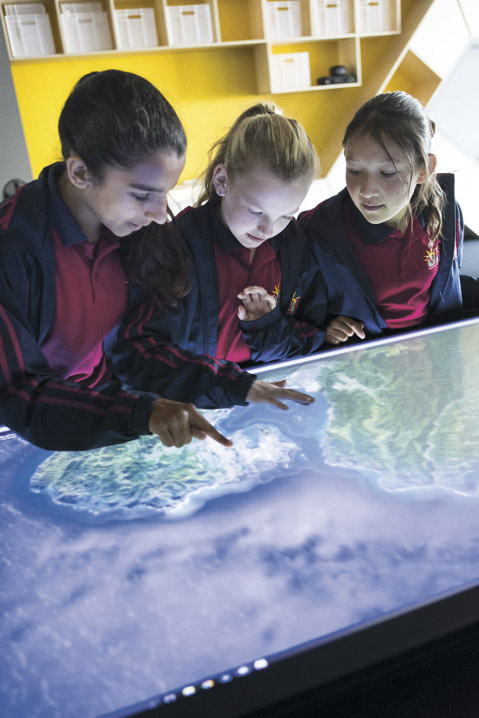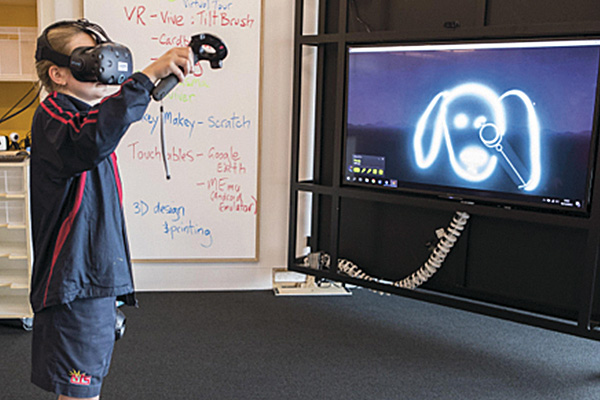Nine months ago, I was employed by the Museum of New Zealand Te Papa Tongawera to create a Learning Lab. Te Papa wanted to remake its classroom space into an innovative high-tech learning environment and provide experiential cross-discipline education programs for schools and the public. I had experience creating makerspaces and innovative learning spaces previously in schools and companies, but this was my first time working for a museum. Te Papa’s awesome staff, innovative vision and mission to “change hearts, mind and lives” make it a unique and inspiring place to work. It has been an amazing and slightly magical journey creating Hīnātore | Learning Lab. We have just finished construction. Last week, we had our first group of learners (beta testers) from Newlands Intermediate School come in for a demo session. Students from Wooranna Park Primary School in Melbourne also beamed in to collaborate via Google Hangout (telepresence). The session was a huge success. Everyone had a blast and it was heart-warming to see the space come alive with excited learners.
We designed Hīnātore for learners. We wanted to create a learning commons where everyone who enters the space has a sense of ownership and fun. All the furniture and technology is multipurpose and flexible. ‘Swiss Army’ tables swing out from wall units, movable wall panels transform to create media studios and cushioned comfy nooks are built into the cupboards. Everything in Hīnātore is made to be moved and used by its occupants. The space transforms to support the needs of learners. The Swiss Army tables were a hit with the kids in Melbourne. They kept asking Ronelle (the Newlands Intermediate student giving them a virtual tour) to demonstrate their functionality.
We have developed the first release of learning programs for 2017. Hīnātore learning sessions are cross-disciplinary, support learners’ development across the 21st century core competencies (creativity, communication, collaboration and critical thinking) and deepen engagement with Te Papa’s collections and exhibitions. In our Pacific Explorers program, learners experience our Tangata o le Moana exhibition, design a Cook Islands-style vaka digitally in 3D and print their personal creations using 3D printers. They learn pacific navigation techniques with star charts in virtual reality (VR) and create their own inter-island navigational stick charts. We are also running workshops for the general public. After school on Tuesdays, kids can learn to code and develop games at Play Inc. sessions. Families can play and create together in the Build a BugBot session and adults can tap into their creativity in Creative Jam workshops. Public workshops will be available to book in January 2017.

The Learning Lab is kitted out with some seriously cool technology. We wanted to explore and develop new ways of learning with transformative tech. Hīnātore contains 3D printers, 3D scanners, touch tables, a range of VR systems (including a custom-made VR studio) and telepresence systems that enable real-time collaboration with people around the globe. We specifically chose technologies that empower creativity and enable collaborative learning in ways not previously possible. Our learning programs employ VR applications that enable real-time collaboration between geographically distant participants. In Hyper Room, people can communicate, create and brainstorm in a shared virtual space. Tilt Brush is a VR painting and sculpting application that allows the user to create room-size artistic creations. Cardboard camera is a smartphone app that enables easy creation of VR videos which can be viewed in a cardboard VR viewer and shared instantly with friends and networks.
Te Papa has amazing objects and taonga in its collections and exhibitions to learn from. At Hīnātore, we have a special touchable collection that people can handle. We want to extend and enhance object-based learning with digital technologies. Our touch tables can respond to objects placed on them (using fiducial markers) and provide learners with a choice of learning paths linked to the specific objects. Learners can scan collection objects with our 3D scanners and print their own copy, or create their own bespoke 3D designs and print them. We chose technologies for the Learning Lab that encourage making. Kids attending our after-school Play Inc. program will have the opportunity to create their own digital games using coding and creative electronics.
Part of our mission at Hīnātore is expanding our learning community locally and internationally. We want to support learners collaborating on shared topics and comparing cultural perspectives. The Google Hangout during the demo session with Wooranna Park Primary in Melbourne and Newlands Intermediate in the Learning Lab worked well. After talking as a whole group, Ronelle (Newlands student) took the Melbourne kids on a tour of our exhibitions using a smartphone and gimbal. My favourite part of this virtual tour was seeing the learning happening at both ends of the connection. When the kids in Melbourne asked where the vaka they were viewing was from, Ronelle read the label and relayed the information in her own words. We have also developed virtual excursions for schools who cannot make it to Te Papa. Using mobile technologies, Te Papa’s educators give school groups a personalised tour of exhibitions.
We have developed the learning programs at Hīnātore to be fun, learner centric and informed by the latest research. We are transforming the old ‘chalk and talk’ way of learning into something shared and co-creative. Building on the concept of Ako, everyone brings knowledge to share and new knowledge can arise from shared experiences. Hīnātore is Māori for phosphorescence or luminescence. It symbolises the shimmering lights of inspiration that mark the beginning of a learning journey.
A huge thanks to my team and everyone who helped make Hīnātore a reality!
Hīnātore | Learning Lab at Te Papa opens in February 2017. I hope you can join us for a learning adventure!
Matt Richards is an educational leader, learning innovator and technologist. He is the Senior Advisor Learning Innovation at the Museum of New Zealand Te Papa Tongarewa, creating innovative learning spaces and programs. Matt pioneered the maker education movement in Australian schools and founded an international games-based learning project. He employs emerging technologies to empower learners and build global learning communities. Matt is a Google Certified Innovator and Microsoft Innovative Educator Expert.


Latest posts by etsmagazine (see all)
- Introducing the MOBIUZ Ultrawide Curved Gaming Monitor – The Next Evolution in E-Gaming - January 28, 2022
- Technology For Inclusion With Diverse Learners - December 3, 2019
- 2020 Vision for Interactive Learning in Tomorrow’s Classroom - April 29, 2019
You must be logged in to post a comment.


There are no comments
Add yours